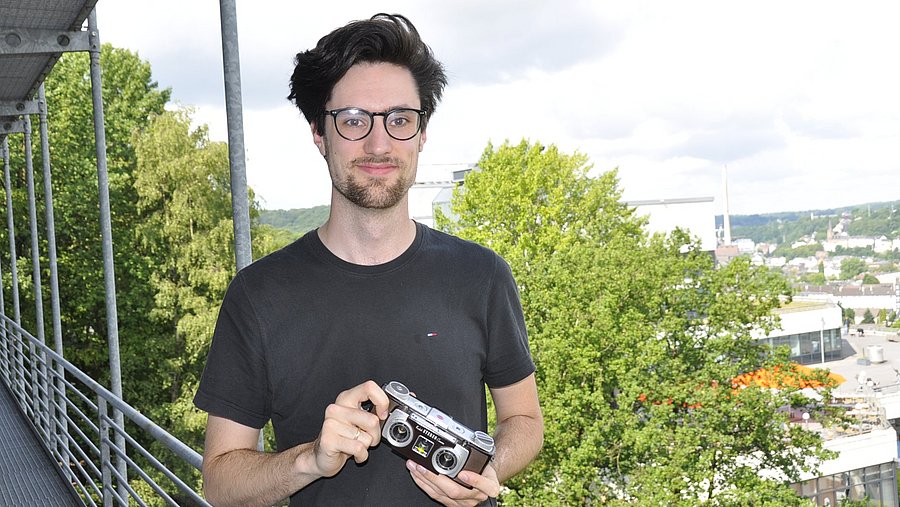
Spatial images - a different view of Germany
Philipp Roling / Industrial Design
Photo: UniService Transfer
Spatial images - A different view of Germany
The Fundación FBS in Spain is home to one of the largest stereoscopic collections in the world. Philipp Roling, a student at the University of Wuppertal, is working on a project with the foundation entitled 'Spatial images in Germany' and is photographically recreating places and objects from the 1920s a hundred years later.
It is not yet entirely clear whether the collection of the Spanish couple Yolanda Fernández-Barredo Sevilla and Juan José Sánchez Garcia is the largest collection of stereoscopic objects in the world, but there is no question that it is one of the most extraordinary collections of photographic objects. Curating it and making it accessible to science will soon be the task of Dr. Carmen Pérez González, lecturer in the history of science and technology at the University of Wuppertal, who is already conducting research on some of the German objects in the collection in a pilot project with students.
The Fundación FBS collection
It all began in 1978, when Juan José Sánchez Garcia, then an architecture student, bought his first stereoscope with the accompanying images, thus founding what is now one of the largest collections of stereoscopic photography. Over the years, he found more objects in old libraries, second-hand bookshops and at flea markets. Together with his wife Jolanda, who was writing her doctoral thesis on 19th century architectural photography with a focus on stereoscopic photography in Madrid at the time, he continued to search for interesting objects while she took care of text sources and their documentation, as this growing collection would eventually be usable for future research. It now contains around 350,000 photographs, of which more than 80% are stereoscopic photographs, including some exceptional daguerreotypes and autochromes, more than 1000 viewers, 30 cameras, more than 1000 different devices and apparatus and 19th century furniture for storing, preserving and sorting stereoscopic photographs, as well as a library of 10,000 publications. On May 5, 2023, the time had come. The two architects established the 'Fundación FBS' foundation in Granja de San Ildefonso, while the collection itself is located in Madrid.
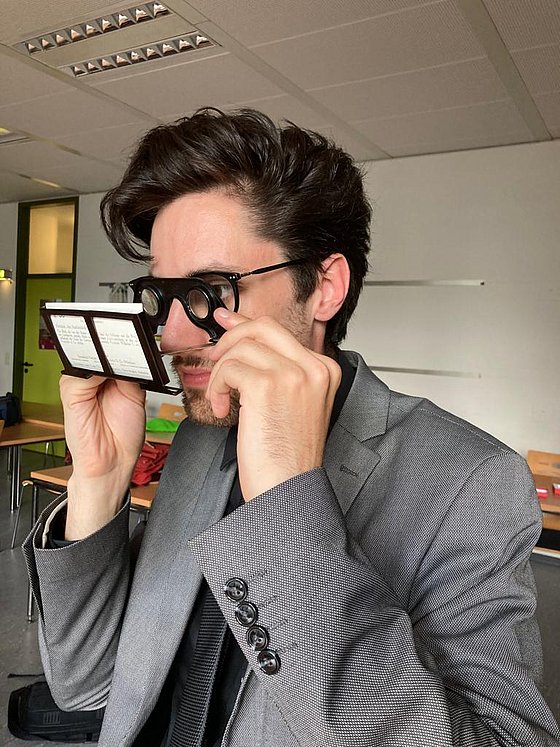
Philipp Roling with the original viewer of the stereo photographs
Photo: Carmen Pérez González
Stereoscopic photography - a student gets curious
During the seminar, in which student Philipp Roling also took part, the seminar leader presented, among other things, a stereoscopic image viewer with stereoscopic photographs in a box. The photographs in the box were taken during the Weimar Republic and show 100 spatial images from Germany in the 1920s and 1930s. "Stereoscopic photography is the taking of two pictures that are taken quasi spatially, i.e. they are shot at a distance that roughly corresponds to that of the eyes, which in turn can be done with one camera and two angles of view or with a specific stereoscopic camera that takes two pictures directly," says Roling, explaining the special type of photography. "After processing, these photos are printed on small cards, which create an optical illusion and a spatial effect when viewed through special glasses." Fascinated by the technique and the historical results, he took on the project.
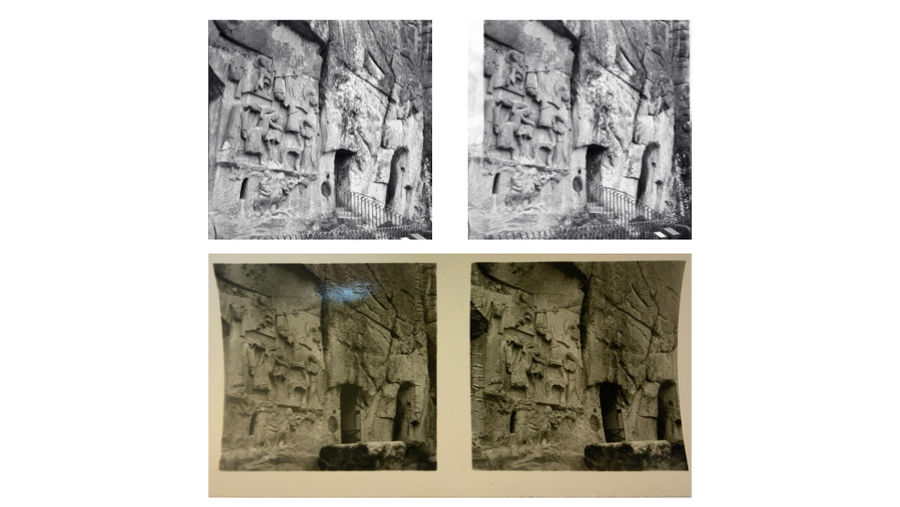
Stereo photography: Externsteine in the town of Horn then and now
Photo: Philipp Roling
Recreating 100 spatial images
Roling set to work and soon found a research approach. "I like to travel, I'm very interested in history and then thought about this project, whether it wouldn't be interesting to capture the changes over almost a hundred years in pictures, because there must have been major changes." And so the student went to the first places to implement his idea. "I had no idea how big the project would end up being." Roling traveled through Germany and discovered over time that many motifs had not only been destroyed by the war, but had also been torn down in the course of social change. "The Gewandhaus in Leipzig, for example, whose ruins only gave way to a new building in the 1960s," he explains, "or ideological buildings and parts of cityscapes were virtually destroyed in the post-war period." Roling based his work on the captions, which provide brief information about the object for each stereo photograph. This limited the location of the object or landscape, but the main difficulty was finding the exact point of view from which the photographer had shot the motif. "While subjects such as Cologne Cathedral from the west are fairly easy to find, it's a different story with a landscape." He then reached his limits for the first time at Drachenfels near Königswinter. "Accessibility is no longer as good as it was back then. You would practically have to climb over the barriers onto an old wall to get the view of the Rhine and Drachenfels in a picture. But that's not possible."
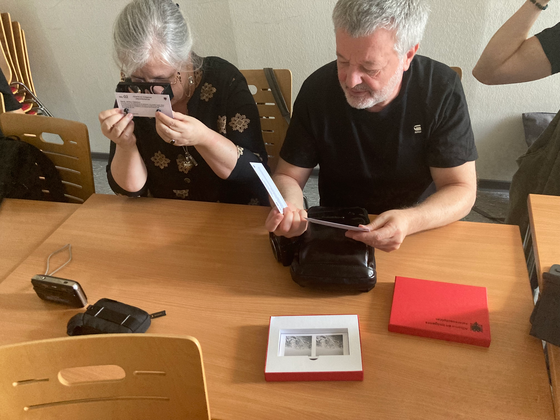
Foundation founder with spatial image box and stereo glasses
Photo: Carmen Pérez González
Help comes from committed citizens
Roling also used the possibility of satellite views to identify prominent points. "In Siegburg, I picked out two church towers, which I then used to find the third point from which the picture was taken. That was the St. Anno church in Siegburg." But it was a rocky road. "I walked the streets using satellite images and checked the entire area until I came across St. Anno's Church."
However, in order to create the actual parallel image of the church, permits had to be obtained, lighting conditions had to be considered and the weather had to be taken into account. "The church tower has been covered in scaffolding for several years and is not open to the public. I then got in touch with a very nice gentleman who allowed me to go up via the construction elevator on the side of the church tower to take the stereo image. I've had this experience several times now, that many people I've approached during the course of the project for permits are very enthusiastic and support this project. I was also allowed to use Aachen's town hall for a short time, the roof of which is no longer accessible."
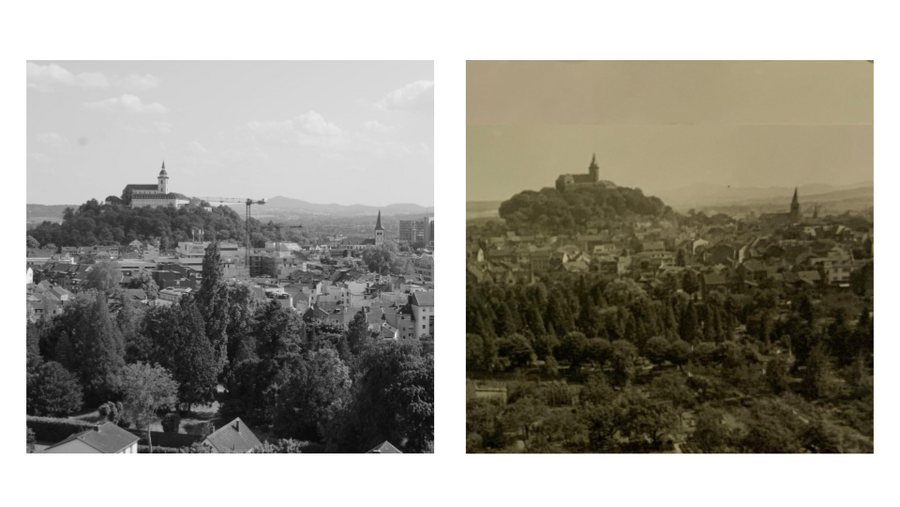
Stereo photography: Siegburg comparison
Photo: Philipp Roling
Project leads to master's thesis
In the meantime, the busy student has already captured 29 objects with the stereo camera. The biggest challenge in the near future will be the enormous distances he has to cover to capture certain subjects. "Many of the pictures were taken in Bavaria and the former Prussia," he explains. "The former Prussia is concentrated in the western region, i.e. places in NRW, Rhineland-Palatinate and Hesse. I was able to get there relatively easily. I also have friends in other federal states, so I was able to combine the two." The entire east and north of Germany and the far south with Bavaria and Baden-Württemberg are now becoming more difficult. This is primarily a financial issue. In addition, some pictures were taken in summer, others in winter, so he has to travel to these places twice. Nevertheless, his enthusiasm is undiminished. "I get insights that aren't even really granted to the people who live there. For example, the city view in Aachen from the town hall tower, or the view from St. Stephen's Church in Mainz. These are perspectives that are otherwise not available. The pictures are then also made special by the background stories."
With this project, Roling has also found his topic for his Master's thesis, which he continues to prepare with each new photo motif in Germany.
"This is the largest stereoscopic collection in Europe, if not the world," he concludes enthusiastically, "it's a niche in photography. And it is also particularly impressive because we are doing pioneering work by classifying and archiving the objects."
Uwe Blass
Philipp Roling studies Industrial Design at the University of Wuppertal.
